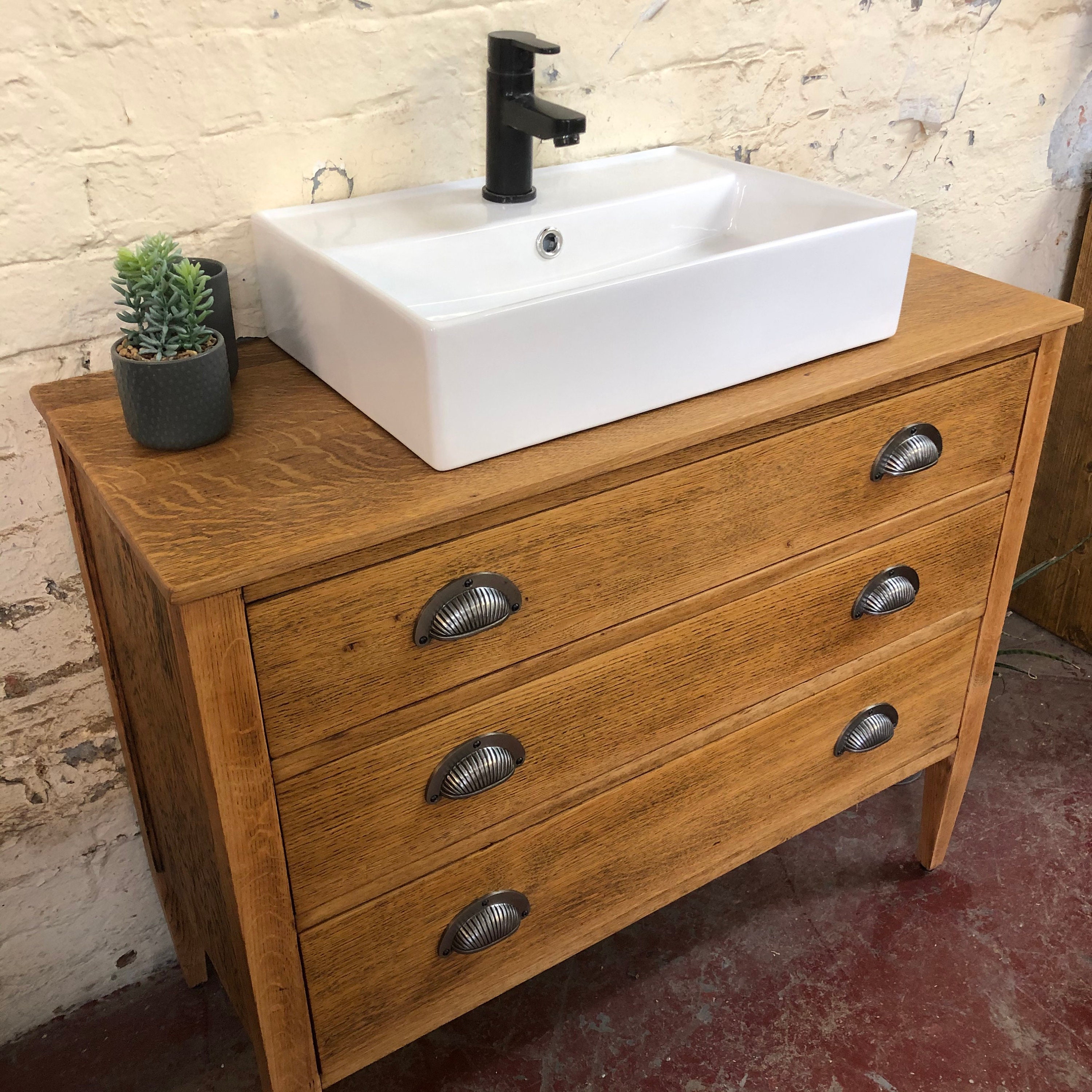Design and Functionality: Weathered Oak Bathroom Vanity

Weathered oak bathroom vanities offer a unique blend of rustic charm and modern functionality. Their natural wood grain patterns and warm tones create a welcoming ambiance, while their durability and versatility allow for a wide range of design styles and practical applications.
Design Styles
Weathered oak bathroom vanities can be customized to suit various design aesthetics, from traditional to contemporary.
- Traditional: Weathered oak vanities with intricate carvings, ornate hardware, and a distressed finish create a classic and timeless look. They often feature pedestal sinks or double sinks with a countertop made of granite or marble.
- Transitional: This style combines traditional elements with modern accents, resulting in a balanced and sophisticated look. Weathered oak vanities in transitional designs often feature clean lines, simple hardware, and a combination of natural wood and contemporary materials like glass or metal.
- Modern: Modern weathered oak vanities emphasize sleek lines, minimal ornamentation, and a focus on functionality. They may feature floating vanities with integrated sinks or vessel sinks, and the wood may be treated with a clear sealant to showcase its natural beauty.
- Rustic: Rustic weathered oak vanities embrace the natural character of the wood, often featuring knots, imperfections, and a rough-hewn finish. They are often paired with farmhouse sinks, open shelving, and reclaimed materials.
Vanity Configurations
Weathered oak bathroom vanities come in various configurations to meet different needs and space requirements.
- Single Vanity: A single vanity is ideal for smaller bathrooms or powder rooms. It typically features a single sink and storage space beneath.
- Double Vanity: Double vanities are perfect for larger bathrooms, offering ample storage and counter space for two people. They usually feature two sinks and a spacious countertop.
- Floating Vanity: Floating vanities create a modern and minimalist look, offering a sleek and streamlined aesthetic. They are mounted to the wall, leaving the floor open for easy cleaning.
- Corner Vanity: Corner vanities maximize space in smaller bathrooms by utilizing a corner space. They often feature a single sink and compact storage.
Practical Considerations
When choosing a weathered oak bathroom vanity, it’s important to consider practical factors like storage options, sink types, and maintenance.
- Storage Options: Weathered oak vanities offer a variety of storage solutions, from drawers and cabinets to open shelves. Consider your storage needs and choose a vanity with sufficient space for towels, toiletries, and other bathroom essentials.
- Sink Types: Weathered oak vanities can accommodate different types of sinks, including pedestal sinks, vessel sinks, undermount sinks, and drop-in sinks. The choice depends on your style preference and bathroom layout.
- Maintenance: Weathered oak is a durable wood, but it requires regular maintenance to preserve its beauty. Apply a sealant to protect the wood from moisture and stains, and clean it with a mild soap and water.
Sustainable Design
To create a truly sustainable weathered oak bathroom vanity, consider incorporating eco-friendly materials and design elements.
- Reclaimed Wood: Using reclaimed weathered oak adds a unique character to the vanity and reduces the environmental impact of deforestation.
- Low-VOC Finishes: Choose low-VOC paints and finishes to minimize harmful emissions and create a healthier indoor environment.
- Energy-Efficient Faucets: Incorporate water-saving faucets to reduce water consumption and conserve resources.
- LED Lighting: Install energy-efficient LED lighting to minimize energy usage and reduce your carbon footprint.
Maintenance and Care

A weathered oak bathroom vanity, with its rustic charm and natural beauty, requires proper care to maintain its aesthetic appeal and longevity. Understanding the nuances of wood maintenance and applying appropriate techniques is crucial for preserving the vanity’s character and ensuring its lasting appeal.
Cleaning and Sealing Techniques, Weathered oak bathroom vanity
Regular cleaning is essential to prevent dirt, grime, and soap residue from accumulating on the vanity’s surface. It also helps to maintain the natural beauty of the weathered oak.
- Use a soft cloth dampened with mild soap and water to clean the vanity. Avoid harsh chemicals, abrasive cleaners, or excessive scrubbing, as these can damage the wood’s finish.
- Dry the vanity thoroughly with a clean, soft cloth after cleaning to prevent moisture buildup.
- Apply a sealant to the vanity’s surface every six to twelve months to protect it from moisture and spills. A water-based polyurethane sealant is a good choice for bathroom vanities, as it provides a durable, moisture-resistant barrier without altering the wood’s natural appearance.
Moisture and Humidity
Bathrooms are inherently humid environments, which can pose challenges for wood furniture. Moisture can cause warping, swelling, and even mold growth if not addressed properly.
- Ensure proper ventilation in the bathroom by using an exhaust fan during and after showers or baths. This helps to remove excess moisture from the air and prevent it from damaging the vanity.
- Avoid placing the vanity directly in front of a shower or bathtub, where it may be exposed to direct water spray. This can lead to water damage and shorten the vanity’s lifespan.
- Consider using a dehumidifier in the bathroom, especially during humid seasons or in areas with high humidity levels. This can help to regulate the moisture content in the air and prevent damage to the vanity.
Restoration Techniques
Over time, a weathered oak vanity may show signs of wear and tear, such as scratches, dents, or fading. While regular maintenance can help to prevent these issues, there are restoration techniques that can help to restore the vanity’s beauty.
- For minor scratches or dents, use a wood filler to repair the damage. Choose a filler that matches the wood’s color and grain pattern as closely as possible.
- To address fading, apply a wood stain to the vanity’s surface. Select a stain that complements the existing color and finish of the vanity.
- For more significant damage, consult a professional wood refinisher. They can assess the damage and recommend appropriate restoration techniques, including sanding, staining, and sealing.
